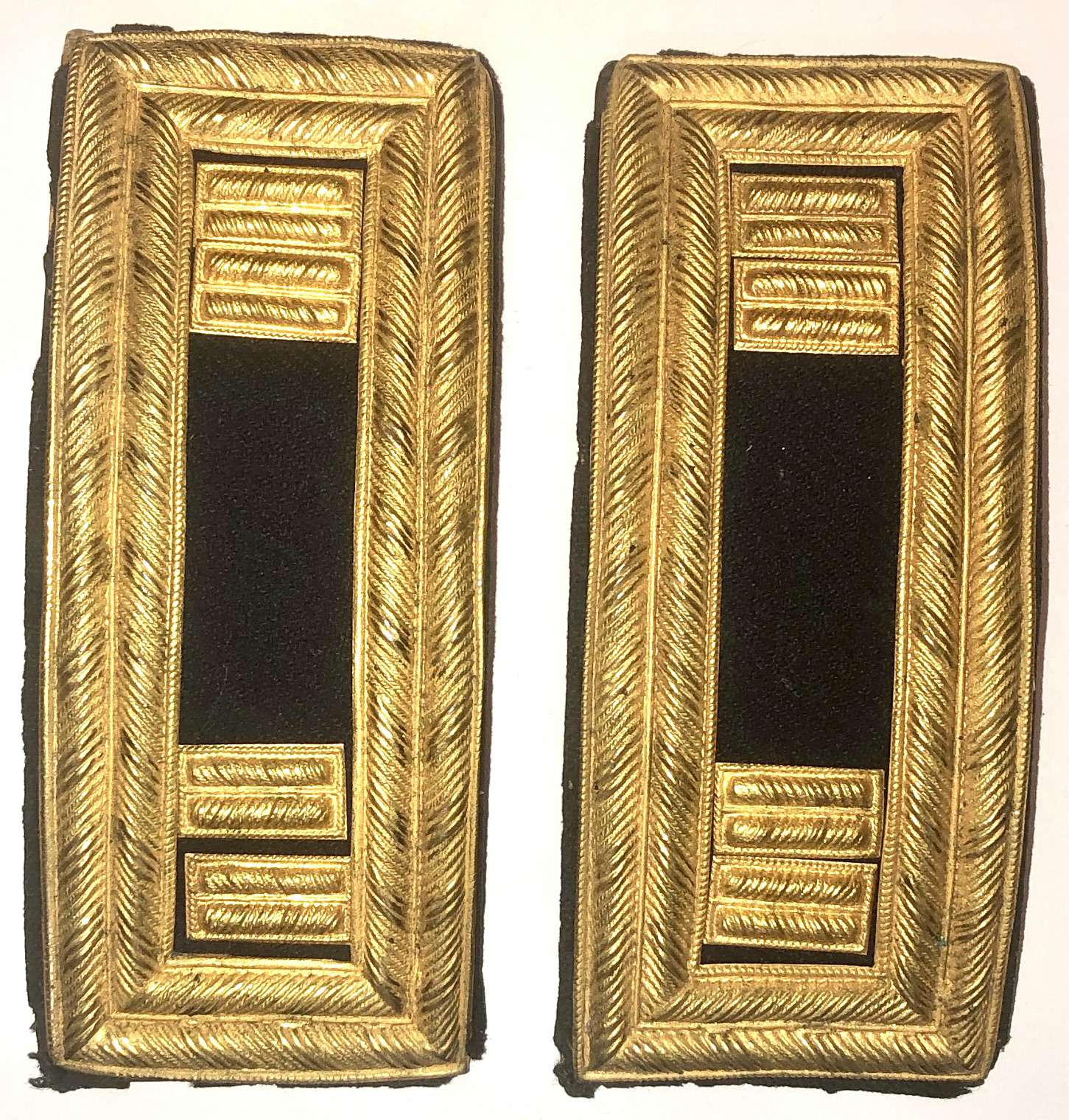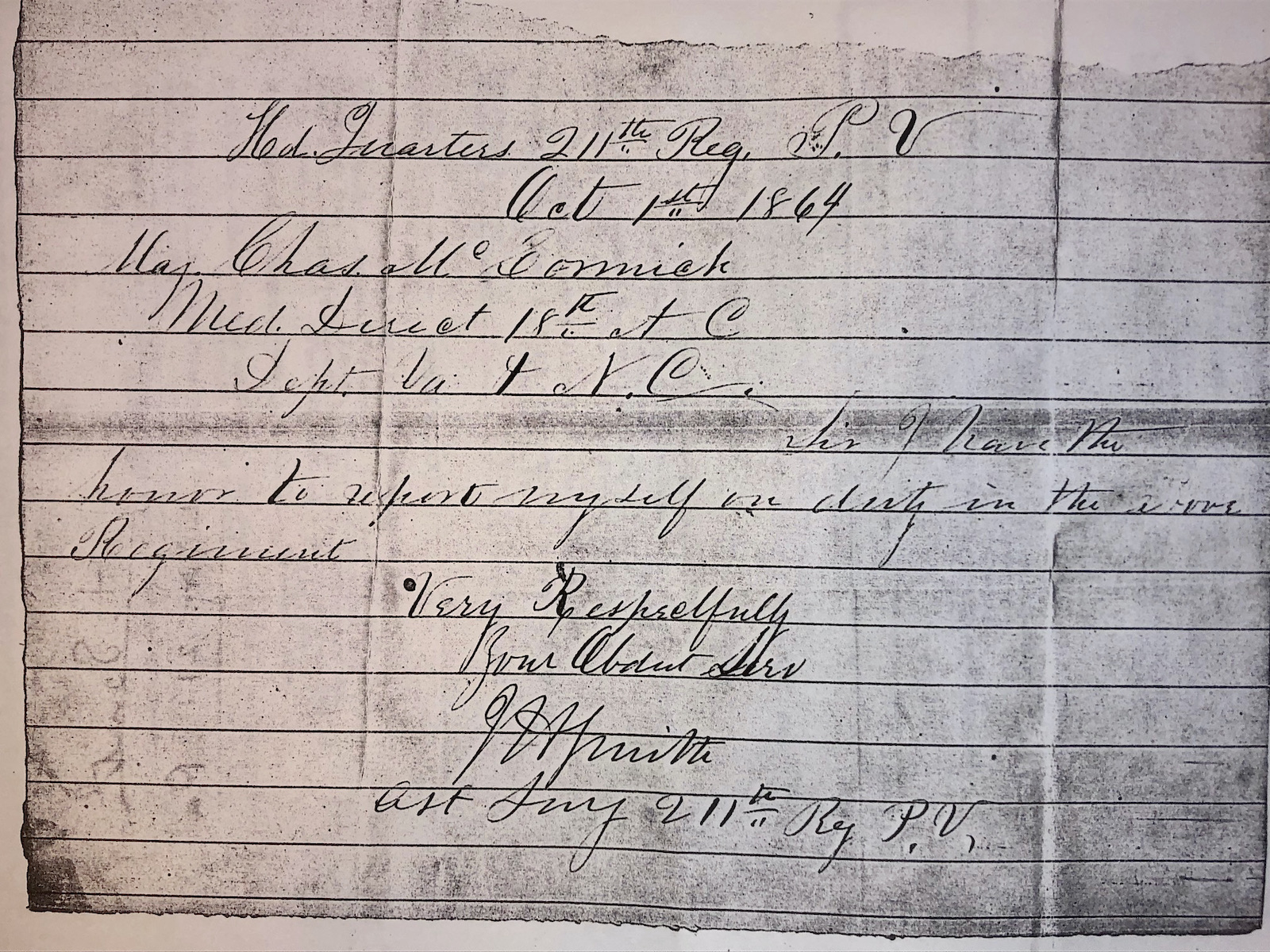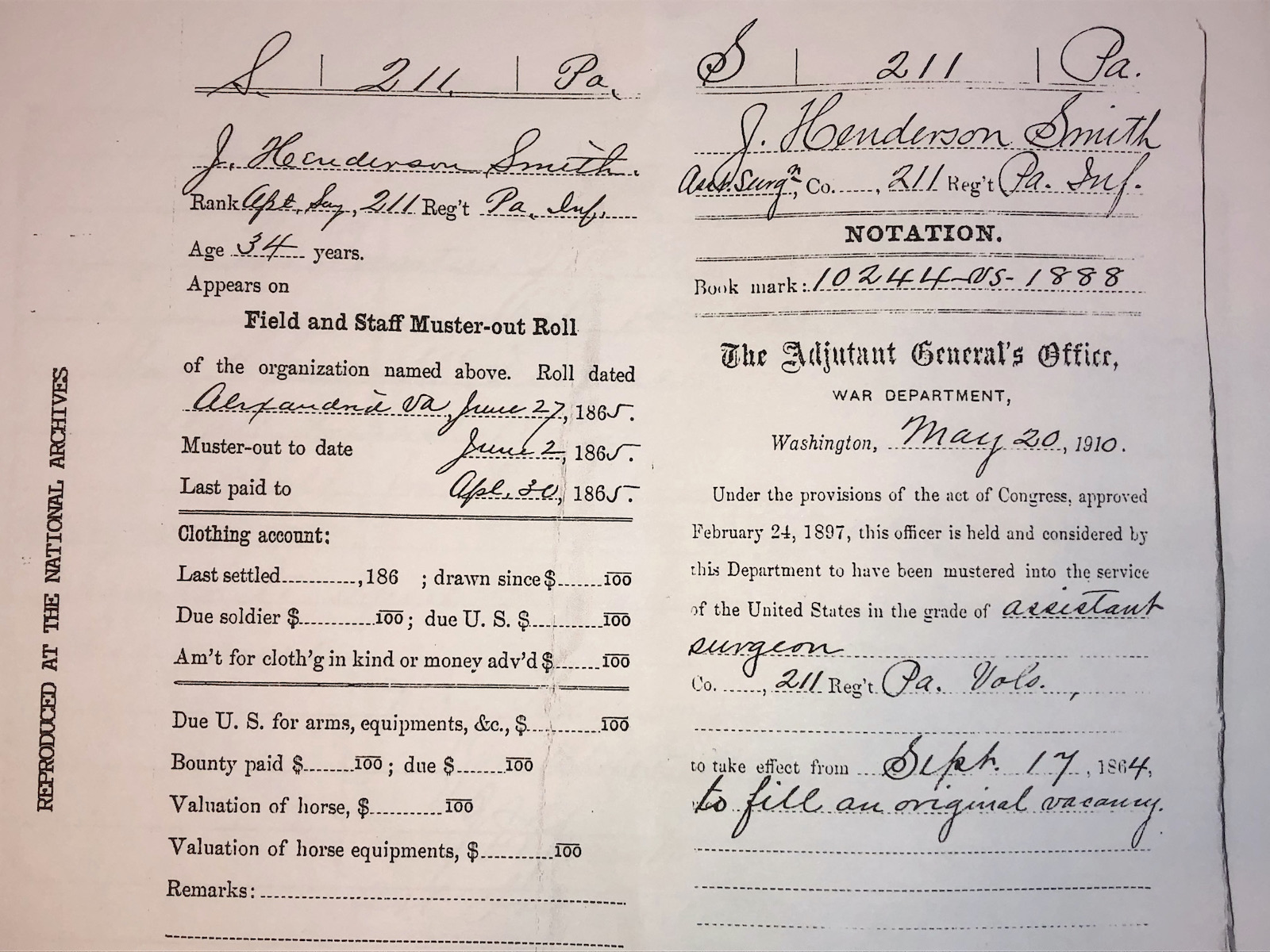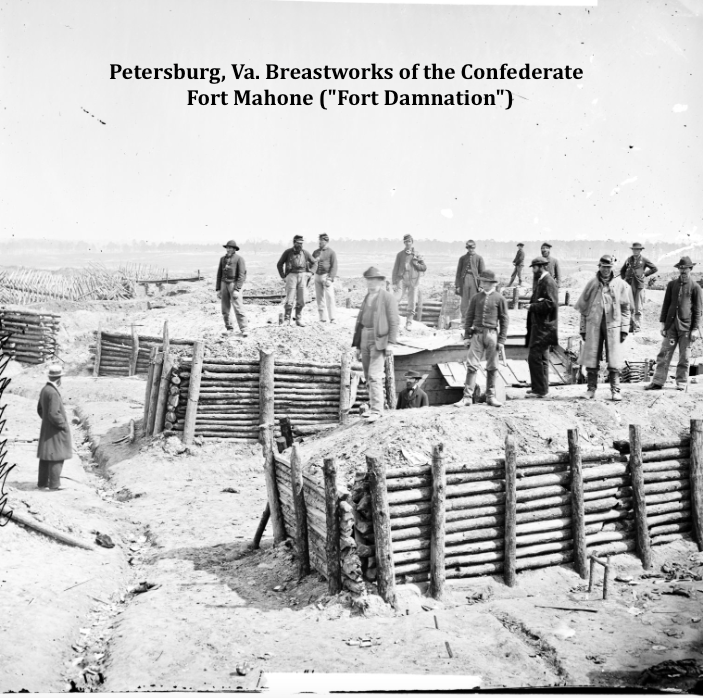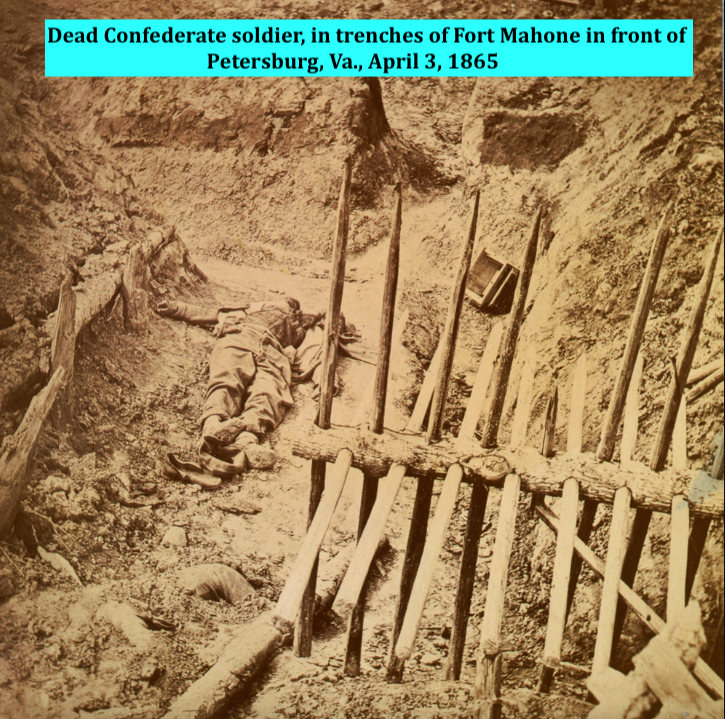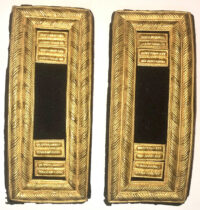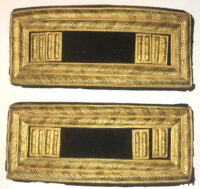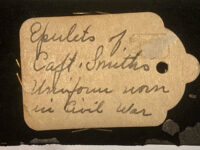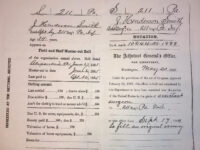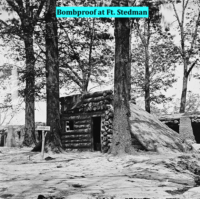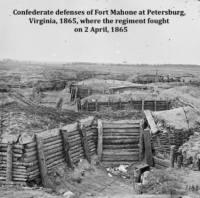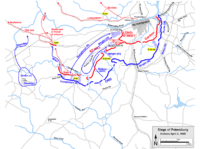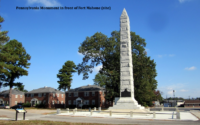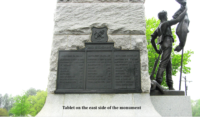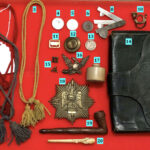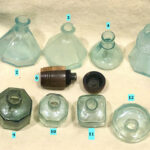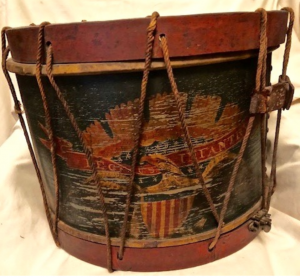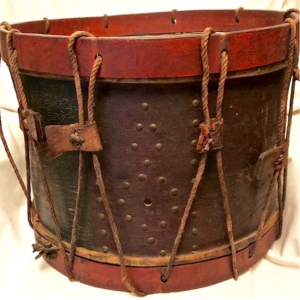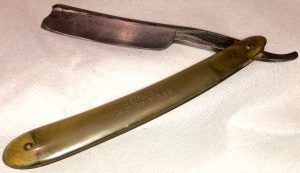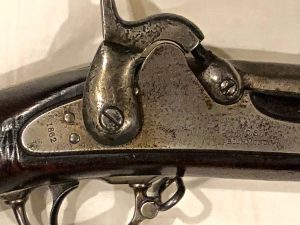Id’d Smith’s Patent Double Bullion Rank Straps – Captain J. Henderson Smith, Assistant Surgeon 211th Pa. Infantry
Id’d Smith’s Patent Double Bullion Rank Straps – Captain J. Henderson Smith, Assistant Surgeon 211th Pa. Infantry – This superb set of Captain’s, rich, black velvet field, Union officer’s rank straps were worn by Captain Joseph Henderson Smith, assistant surgeon of the 211th Pennsylvania Infantry. Dr. Smith, of Pittsburgh, mustered into this late war regiment in September, 1864. At that time,, the Union army was in distinct need of additional troops to assist in the lengthy Petersburg campaign; the 211th Pa. answered that call and were sent immediately to join the Army of the James at Bermuda Hundred, as a regiment in the 2nd Brigade, 3rd Division, 9th Army Corps. By November of 1864, the 211th had become a unit in the Army of the Potomac, providing defense at Bermuda Hundred. After a brief time at Bermuda Hundred, the 211th became active combatants at the Weldon Railroad, then, in early 1865, they were engaged at Hatcher’s Run, the re-taking of Ft. Stedman and participation in the “Breakthrough” or final and successful assault on Petersburg, on April 2, 1865. The regiment would also participate in the pursuit of the remnants of Gen. Lee’s army during the ensuing Appomattox Campaign, culminating their army experience with participation in the Grand Review, in Washington, D.C.
This set of rank straps are Smith’s Patent** types, but decidedly high-end examples – they have the usual sheet brass, faux bullion borders, but these are double bullion, as are both Captain’s bars. The field on which the bars and bullion borders rest is a rich, black velvet – as a surgeon, Capt. Smith would have been a staff officer, hence the black field. Both pairs of the straps remain in excellent condition, with some scattered insect nips on the underside of each strap. The undersides of the straps are composed of a dark, blue wool and do not exhibit the Smith’s Patent stenciling. Of significance, are the labels affixed to the underside of each strap. One of the labels, an old, paper tag, has written in ink, the following:
“Epulets (sic) of
Capt. Smith’s
Uniform worn
in Civil War”
The second label, affixed to the other strap’s underside, is inked:
“Assn. Surgeon J.W.C.
211th Penna. Inf.”
** The Smith-Patent straps utilize stamped brass imitation embroidery borders with stamped brass rank device on a cloth field (color depending on branch of service). Since made of metal, but worn on the shoulders, they have a convex plane when viewed from the side, i.e. they are curved to fit the shoulder. They are generally about 4” long x 1 5/8” wide. The gold gilt stamped brass imitation embroidery border is about 3/8″ wide.
When viewed from the back, each strap bottom has a dark underlayment material sewn directly to the backing material, and in some cases a label remains. Some of his straps are also marked with stenciled or stamped marking rather than a paper label. James S. Smith was a military outfitter whose business was located at 15 Dutch Street in New York City.
J Henderson Smith
| Residence was not listed;
Enlisted on 9/14/1864 as a Asst Surgeon.
On 9/14/1864 he was commissioned into Field & Staff PA 211th Infantry He was Mustered Out on 6/2/1865 at Alexandria, VA
(In 1890, living in Pittsburgh, PA) |
211th PA Infantry
( 1-year )
| Organized: Camp Reynolds, Pittsburgh, PA on 9/16/64 Mustered Out: 6/2/65 at Alexandria, VAOfficers Killed or Mortally Wounded: 6 Officers Died of Disease, Accidents, etc.: 0 Enlisted Men Killed or Mortally Wounded: 38 Enlisted Men Died of Disease, Accidents, etc.: 53 (Source: Fox, Regimental Losses) |
| From | To | Brigade | Division | Corps | Army | Comment |
| Oct ’64 | Nov ’64 | Provisional | 18 | Army of the James | ||
| Nov ’64 | Dec ’64 | Hartranft’s | 9 | Army of Potomac | ||
| Dec ’64 | Jun ’65 | 2 | 3 | 9 | Army of Potomac | Mustered Out |
Military: Civil War: E, H, I, K Comps, 211th Regiment PA Volunteers: Westmoreland Co
____________________________________________________
Extracted from Bates’ History of the 211th Regiment of PA Volunteers
Company A recruited in Crawford County
Company B in Jefferson
Company C in McKean and Jefferson
Company D in Mercer
Company F in Erie
Company G in Warren
Companies E, H, I, and K in Westmoreland
Unassigned men.
There was no Company J
____________________________________________________
HISTORY OF THE TWO HUNDRED AND ELEVENTH REGIMENT PENNSYLVANIA VOLUNTEERS
Company A of this regiment was recruited in Crawford county, B in
Jefferson, C in M’Kean and Jefferson, D in Mercer, F in Erie, G in Warren,
and E, H, I and K in Westmoreland. The companies rendezvoused at Camp
Reynolds, near Pittsburg, where, on the 16th of September, 1864, a
regimental organization was effected with the following field officers:
James H. Trimble, Colonel; Levi A. Dodd, Lieutenant Colonel; Augustus A.
Mechling, Major. Soon after its organization, it moved for the front, and
on the 20th, was placed in the intrenchments at Bermuda Hundred, where it
was incorporated with a provisional brigade in the Army of the James. It
had scarcely reached its position, when it was ordered to mount the
parapets, in full view of, and in point blank range of the enemy’s guns.
The sudden appearance of the long lines of men upon the sand-bags, of which
the works were constructed, attracted his attention, and he immediately
opened upon them with his batteries. Two men of company F, were instantly
killed by a single shell. The object of thus exposing the command, was to
divert attention from the storming party which was about to move upon Fort
Harrison, and which gallantly carried that work. The picket line, which
the regiment was required to hold, extended to the James River on the
right, opposite Dutch Gap, through a dense pine wood to an open space,
where was the regimental encampment. This space, a fourth of a mile in
width, had been cleared of timber, by converting it into an impenetrable
slashing, over which an unobstructed view of the enemy was given. The line
after leaving the river was nearly straight until it reached this slashing,
where it made an abrupt bend, leaving the apex of the angle close to the
enemy’s line. At this point, many rebel deserters came in to the Union
lines. So common had this practice become, that is was proving a serious
drain upon the rebel strength; so much so, that General Pickett, who was in
command, determined to stop it. The most friendly relations has subsisted
between the opposing picket lines, the men frequently meeting for social
conference and banter. But on the night of the 17th of November, quietly
massing a picked body of men, the rebel leader suddenly burst upon the
Union pickets, and before they could rally, or supports could come to their
aid, captured fifty-four of their number, seizing this projecting angle,
and before morning, had built a redoubt, and so strengthened his lines,
that General Grant, after a careful survey of the ground, deemed it
expedient to attempt to retake it. This was the end of the truce on the
part of the pickets, hostilities never ceasing afterwards for an instant,
and so long as the regiment remained on that line, the men were obliged to
hug the breastworks, or lie close in the bomb-proofs.
On the 27th of November, the Two Hundred and Eleventh, with other
Pennsylvania regiments with which it had been brigaded, was relieved by a
brigade of colored troops, and was ordered to join the Army of the Potomac,
on the south side of the Appomattox. These regiments were subsequently
organized into a division, which became the Third of the Ninth Corps, to
the command of which General Hartranft was assigned, the Two Hundred and
Eleventh, Two Hundred and Fifth, and Two Hundred and Seventh, under command
of Colonel Matthews, forming the Second Brigade. During the winter, the
regiment was thoroughly drilled, and made occasional expeditions with the
troops of other corps, but without becoming engaged, though a considerable
amount of fortifying was done in the movement upon Hatcher’s Run, and the
troops were there held in momentary expectation of bloody work.
Before the opening of the spring campaign, Colonel Trimble resigned, and
was succeeded by Lieutenant Colonel Dodd. The camp of the regiment was
located midway between Fort Howard and Fort Alexander Hayes, on the Army
Line Railroad, to the extreme left of the division, which was posted in
rear of, and acted as a support to the Ninth Corps line. At the moment
when this line was broken at Fort Steadman, at early dawn, on the morning
of the 25th of March, 1865, and the fort and a considerable portion of the
line was captured, the Two Hundred and Eleventh was resting in its camp,
nearly four miles away. The Colonel and Major were absent, and the
Lieutenant Colonel was sick in hospital. The command consequently devolved
on Captain William A. Coulter. It was quickly summoned to the scene of
disaster, and marching rapidly, reached division headquarters at half-past
six A.M. With little delay it was led by order of General Hartranft, to
the high open ground about Meade Station, just in rear of Fort Steadman,
where it was formed and awaited the order to charge. The other regiments
of the division, which were all nearer the scene of disaster than this, had
been gathered in, and having checked the enemy’s advance, were holding him
at bay. A strong line had been drawn around the fatal break, and the best
possible disposition of the division for strength and efficiency, had been
made. General Hartranft felt satisfied that the enemy could make no
further advance, and that by a united assault, his division could re-take
the captured works. His plan of attack was most ingenious. He already had
five of his regiments posted in the immediate front, advantageously formed
for a dash upon the enemy, who was swarming upon the fort, the covered
ways, and bomb-proofs. The Two Hundred and Eleventh was a mile away, but on
high open ground. It was a large regiment, and if put in motion, drawn out
in line, would instantly attract the attention of the foe, and, as he
believed, would draw the fire of his artillery upon it. His other
regiments, thus relieved from peril, could rush upon, and overpower him.
He accordingly sent word to their commanders to hold themselves in
readiness to charge in fifteen minutes, and the signal to start, should be
the forward movement of the Two Hundred and Eleventh, which was in full
view of them all. General Hartranft determined to lead this regiment in
person, and though he expected that it would be sacrificed by the fire
which the enemy could bring to bear upon it, he was ready to share its
peril, in order that his division might be victorious. The regiment was
accordingly formed, with nearly six hundred muskets in line, and put in
motion. In the most perfect order, and in the most gallant manner, it
moved forward; but contrary to the expectation of General Hartranft, the
enemy, at the sight of the advance of so fine a body of men, instead of
turning all his guns upon it, as was in his power to do, began to waiver,
and when the combined forces of the division rushed on with unflinching
determination, he had little heart to offer opposition, and the fort, guns,
small arms, and many prisoners were speedily taken. At the moment when all
the plans had been perfected, and the columns were upon the point of
moving, General Hartranft received and order from General Parke, in command
of the corps, not to attempt to re-take the fort, until reinforcements from
the Sixth Corps, which were on the way to his support, should arrive. But
the order to move had already gone forth, and it could not be safely
re-called. He accordingly decided that it was better to disregard, that to
obey orders, and when the moment came, dashed forward with his men, winning
a brilliant and most signal victory. The captures made by the division,
were fully shared by the regiment. Fortunately, the loss was but slight,
being one killed and ten wounded.
Great activity all along the Union lines was soon after inaugurated, and on
the night of the 30th, preparations were made by the division to assault.
It was, however, deferred until the morning of the 2d of April. At a
little before midnight on the 1st, the regiment moved to the camp of the
Two Hundred and Seventh, where it remained until half-past three of the
following morning. It then moved to he front, passing around the right of
Fort Sedgwick, and was formed with the brigade, in column by regiments, the
left resting on the Jerusalem Plank Road, the First Brigade standing in
like formation, just in its rear. A strong force of pioneers was detailed
from the leading brigade, well provided with axes and spades, all under
command of Lieutenant Albert Alexander, of the Two Hundred and Eleventh, to
open the way for the movement of the column. When all was in readiness,
the word to advance was given. The pioneers, closely followed by the
division in close column, and joined on right and left by other troops of
the corps, went forward, and in an instant the heavy blows of the axe-men
upon the well adjusted abatis and chevaux-de-frise, were heard. The work
of destruction was scarcely begun, when a fearful discharge of grape and
canister was brought to bear upon them, before which the stoutest might
well quail. But closing up where their ranks were swept away, they soon
broke the obstructions, and, assisted by the ready hands of the troops
which followed, had ample opening for the advance of the column. With a
rush, the ground in front of the rebel works was cleared, and pushing up
the steep and slippery of the forts, the troops were soon in complete
possession, the enemy either captives or in full retreat, and the rebel
main line of works, from a short distance beyond the Jerusalem Plank Road
on the left, to a point four hundred yards to its right, was triumphantly
carried and held by the division. The guns were immediately turned upon
the foe, and with his own ammunition, death and destruction was dealt upon
him. Not without a fierce struggle was the ground held, for the enemy,
intent on re-gaining his lost ground, made repeated charges. But hastily
throwing up lunets, for the protection of the gunners, and rifle-pits for
the infantry, the division succeeded in repulsing every assault. But this
signal victory was not gained without signal loss. Of the Two Hundred and
Eleventh, four officers and seventeen enlisted men were killed, four
officers and eighty-nine men wounded, and twenty-one missing, an aggregate
of one hundred and thirty-five. Lieutenant Charles M’Lain, and Lieutenants
Andrew J. Sparks, Albert Alexander, and John P. Tarr, were killed, and
Major Elias B. Lee, and Lieutenant John M. Pelton, mortally wounded.
Captain James D. Gourlay, and Lieutenant Thomas C. Gilson, were severely
wounded. Few more desperate assaults, and none more successful, were
delivered during the war, than this.
During the following night, the enemy quietly withdrew from the front, and
evacuating the city under cover of darkness, retreated rapidly. The
division entered on the following morning, with little opposition. The Two
Hundred and Eleventh was immediately ordered forward to the Appomattox, to
picket the river bank. The railroad bridge and foot bridge, were both
found on fire. By vigorous efforts the former was saved, and part of the
latter. Towards noon, the regiment marched back to camp. The remainder of
its history is quickly told, for hostile operations were now at an end. It
followed along the South Side Railroad, in charge of trains, until it
reached Nottoway Court House, where news of the surrender of Lee was
received, and where it remained until the 20th, and then proceeded via City
Point to Alexandria. Here it encamped, and here, on the 2d of June, it was
mustered out of service.
____________________________________________________________________________
211TH REGIMENT PENNSYLVANIA VOLUNTEERS FIELD AND STAFF OFFICERS
NAME RANK DATE OF REMARKS
MUSTER
INTO
SERVICE
James H. Trimble Colonel Sep 16, ’64 Discharged March 18, 1865
Levi A. Dodd Colonel Sep 16, ’64 Brevet Brig, Gen.,
April 2,1865 –
- from Lt. Col.April 4,
1865 – Discharged
August 3, 1865
William A. Coulter Lt. Col. Sep 10, ’64 Promoted from Capt.
Company D, May 10, 1865 –
mustered out with
regiment, June 2, 1865
Augustus A. Mechling Major Sep 14, ’64 Com. 2d Lieut. March 19,
1865 – not mustered –
discharged May 3, 1865
King Smith Major Sep 16, ’64 Promoted from Adjutant,
May 10, 1865 – mustered
out with regiment June 2, 1865
Herman F. Steck Adj. Sep 5, ’64 Promoted from 1st Sgt.
Company B May 11, 1865 –
mustered out with
regiment June 2, 1865
Cyrus Townsend Q. M. Aug 22, ’62 Promoted from Q.M. Sergt.
140th Regt. P.V.
Oct 8,1864
mustered out with
regiment June 2, 1865
White G. Hunter Surg. Sep 12, ’62 Promoted from Asst.
Surgeon 149th Regt. P.V.
Sept 22, 1864 – mustered
out with regiment
June 2, 1865
Alfred P. Steckel As. Sur. Sep 14, ’64 Mustered out with
regiment June 2, 1865
J. Henderson Smith – As. Sur. Sep 14, ’64 Mustered out with regiment June 2, 1865
John W. Plannett Chap. Oct 28, ’64 Mustered out with
regiment June 2, 1865
211th Pennsylvania Infantry Regiment
| 211th Pennsylvania Volunteer Infantry | |
| Active | 16 September 1864–2 June 1865 |
| Country | United States of America |
| Allegiance | Union |
| Branch | Union Army |
| Role | Infantry |
| Engagements | American Civil War |
The 211th Regiment Pennsylvania Volunteer Infantry was an infantry regiment of the Union Army in the American Civil War. Raised in western Pennsylvania in September 1864, the regiment initially served with the Army of the James during the Siege of Petersburg, holding trenches at Bermuda Hundred. In late November it transferred to the Army of the Potomac and during the northern hemisphere spring campaign fought in the counterattack during the Battle of Fort Stedman and the Union breakthrough at Petersburg. During the last days of the Appomattox Campaign it guarded trains, and participated in the Grand Review of the Armies following the end of the war before mustering out.
History
Formation and Army of the James service
The 211th Pennsylvania was raised in western Pennsylvania during September 1864 in response to President Abraham Lincoln‘s call for 500,000 men. A large number of its soldiers were veterans on their second enlistment.[1] Company A was composed of men recruited in Crawford County, Company B in Jefferson County, Company C in McKean and Jefferson Counties, Company D in Mercer County, Companies E, H, I, and K in Westmoreland County, Company F in Erie County, and Company G in Warren County. The ten companies of the regiment moved to Camp Reynolds near Pittsburgh, where they were organized on 16 September under the command of volunteer officer Colonel James H. Trimble. After completing its organization, the 211th Pennsylvania was sent to the front and took up positions in the trenches at Bermuda Hundred, Virginia on 20 September; it joined the Provisional Brigade of the Defenses of Bermuda Hundred of the Army of the James in the Siege of Petersburg, Virginia.
Soon after its arrival at the front, the regiment mounted the parapets of its trenches and exposed itself to Confederate fire to divert attention from the successful Union attack on Fort Harrison; two men of Company F were killed by a single shell during this action. The regiment held a picket line from the James River opposite Dutch Gap through dense woods to its camp in a cleared area whose apex projected near the Confederate line. Fraternization between the opposing pickets was routine, but this state of affairs ended when Confederate division commander George Pickett launched a night attack on 17 November that captured 54 Union pickets and the angle, where a redoubt was constructed. Union commander Ulysses S. Grant considered retaking it inadvisable, and from this point hostilities in earnest resumed in the regimental sector, forcing its soldiers to remain under cover while in the trenches.
Army of the Potomac service during late 1864 and early 1865
The regiment and the rest of the Pennsylvania regiments which formed the Provisional Brigade were relieved by a United States Colored Troops brigade on 27 November and transferred to the IX Corps of the Army of the Potomac, holding positions on the southern bank of the Appomattox River. The brigade was organized during December into the 3rd Division of the corps, commanded by Brigadier General John F. Hartranft. The 211th became part of the 2nd Brigade of Colonel Joseph A. Mathews alongside the 205th and 207th Pennsylvania. During the northern hemisphere winter of 1864–1865, the regiment spent most of its time training. This routine was broken by its participating in several forays without being involved in fighting, supporting the Weldon Railroad expedition between 7 and 11 December and the Battle of Hatcher’s Run from 5 to 7 February 1865, doing much fortifying in the latter.[3] Trimble resigned on 18 March, and was replaced in command by Lieutenant Colonel Levi A. Dodd. The regiment encamped in the rear of IX Corps halfway between Fort Howard and Fort Alexander Hays on the Army Line Railroad, a supporting position on the far left of the division.
Fort Stedman
When Fort Stedman was captured by a Confederate attack before dawn on 25 March, the regiment was in camp almost four miles away. Command devolved on Captain William A. Coulter of Company D as Dodd was sick in hospital and Major Augustus A. Mechling was absent. The regiment was ordered to march to the division headquarters, arriving there by 06:30. Having formed up on the high open ground near Meade Station to the rear of Fort Stedman,[5] the relatively large regiment with almost 600 men advanced in line in accordance with Hartranft’s plan to use it to draw Confederate artillery fire. Hartranft led the advance, which was the signal for the attack of the rest of the division.[4] The fort was quickly recaptured after the Union counterattack resulted in the retreat of the exhausted Confederate troops; the 211th Pennsylvania lost one killed and ten wounded in the fighting[6] while capturing the rear of the fort.
Petersburg breakthrough and Appomattox
The regiment fought in the Appomattox Campaign between 28 March and 9 April, during which it participated in the Union breakthrough at Petersburg on 2 April. The regiment prepared for the assault along with the rest of the division on the night of 30 March, but it was postponed until the morning of 2 April. After marching to the camp of the 207th Pennsylvania just before midnight on 1 April, the 211th moved to the front at 03:30 on 2 April, and took positions alongside the brigade with its left on the Jerusalem Plank Road. Lieutenant Albert Alexander of Company D commanded a detail of pioneers from the brigade, which cut down the abatis and chevaux de frise in front of the Confederate positions despite artillery fire. Behind the pioneers, the division advanced, with the 211th closely behind the 207th and 205th Pennsylvania in the column of the brigade.[8] Dodd led the 211th and elements of the 207th towards Fort Mahone after the initial breakthrough and captured it, then brought artillerymen up to turn the guns around.[9] The regiment repulsed multiple counterattacks in fierce fighting, suffering a total of 135 casualties: four officers and seventeen men killed, four officers and 89 men wounded, and 21 missing. Among the dead were Lieutenant Colonel Charles McLain and Alexander, while Major Elias B. Lee was mortally wounded.[6] Privates John C. Ewing of Company E and Amzi D. Harmon of Company K were awarded the Medal of Honor for capturing the flags of the 61st Alabama and the 45th North Carolina, respectively.
On the night of 3 April, the Confederate Army of Northern Virginia retreated from Petersburg, which the division entered on the following morning, meeting little resistance. The 211th picketed the bank of the Appomattox River and saved the railroad bridge and part of the foot bridge from fires started by Confederate forces before marching back to camp in midday. During the pursuit of the Confederate forces it guarded the trains as the army advanced along the Southside Railroad, receiving news of the Confederate surrender at Nottoway Court House on 9 April. The 211th remained there until 20 April, then moved to City Point and lastly Alexandria between 20 and 28 April, where it remained until mustering out. After participating in the Grand Review of the Armies on 23 May, it mustered out on 2 June.[12] During its service, the regiment lost six officers and 38 men killed or mortally wounded, and 53 men to disease, for a total of 97.
Monuments
The designation of the 211th Pennsylvania is inscribed on the monument to Hartranft’s division on the site of Fort Mahone in Petersburg. Its 1909 dedication was attended by veterans of the regiment and the entire division.
From the tablet on the east side of the monument
2nd. Brigade
205th. Regt. Pa. Vol. Inf.
Mustered in Sept. 2, 1864
Mustered out June 2, 1865
Enlistments 1035
Killed 40
Wounded 107
Captured 5
Died of disease 17
Deaths in service 57
Total casualties 169
207th. Regt. Pa. Vol. Inf.
Mustered in Sept. 8, 1864
Mustered out May 31, 1865
Enlistments 1001
Killed 59
Wounded 168
Captured 8
Died of disease 25
Deaths in service 84
Total casualties 260
211th. Regt. Pa. Vol. Inf.
Mustered in Sept. 16, 1864
Mustered out June 2, 1865
Enlistments 955
Killed 51
Wounded 133
Captured 75
Died in prison 25
Died of disease 26
Deaths in service 102
Total casualties 310
211th Pennsylvania Infantry Regiment
The 211th Pennsylvania Infantry Regiment lost 6 officers and 38 enlisted men killed and mortally wounded and 53 enlisted men to disease during the Civil War. The regiment is honored on the monument to Hartranft’s Division in Petersburg, Virginia.
| 1864 | |
| September 16 | Organized at Pittsburg under Colonel James H. Trimble, Lt. Colonel Levi A. Dodd and Major Augustus A. Mechling |
| September | Moved to Bermuda Hundred, Va. and engaged in siege operations against Petersburg and Richmond, Va. attached to Provisional Brigade, Defenses of Bermuda Hundred, Army of the James |
| November 28 | Joined Army of the Potomac before Petersburg for duty in the Defenses of Bermuda Hundred, Va. attached to Provisional Brigade, 9th Army Corps |
| December 7-11 | Movement in support of Weldon Railroad Expedition. Attached to 2nd Brigade, 3rd Division, 9th Army Corps |
| 1865 | |
| February 5-7 | Dabney’s Mills, Hatcher’s Run |
| March 18 | Colonel Trimble discharged |
| March 25 |
Defense of Fort Stedman |
| March 28-April 9 | Appomattox Campaign |
| April 2 |
Final Assault on Petersburg |
| April 3-9 | Pursuit of Lee |
| April 4 | Lt. Colonel Dodd promoted to colonel |
| April 10 | At Nottaway C. H. |
| April 20-28 | Moved to City Point, then to Alexandria |
| May 10 | Captain William Coulter of Company D promoted to lieutenant colonel and Adjutant H. King Smith to major |
| May 23 | Grand Review |
| June 2 | Mustered out |
| NAME: | J Henderson Smith |
| AGE: | 69 |
| BIRTH DATE: | Sep 1830 |
| BIRTHPLACE: | Pennsylvania, USA |
| HOME IN 1900: | Pittsburgh Ward 32, Allegheny, Pennsylvania |
| WARD OF CITY: | 32 |
| STREET: | Wyoming |
| HOUSE NUMBER: | 43 |
| SHEET NUMBER: | 6 |
| NUMBER OF DWELLING IN ORDER OF VISITATION: | 113 |
| FAMILY NUMBER: | 126 |
| RACE: | White |
| GENDER: | Male |
| RELATION TO HEAD OF HOUSE: | Head |
| MARITAL STATUS: | Married |
| SPOUSE’S NAME: | Caroline Smith |
| MARRIAGE YEAR: | 1872 |
| YEARS MARRIED: | 28 |
| FATHER’S BIRTHPLACE: | Pennsylvania, USA |
| MOTHER’S BIRTHPLACE: | Pennsylvania, USA |
| OCCUPATION: | Doctor MD |
Joseph Henderson Smith
BIRTH
unknown
DEATH
1912
BURIAL
Pittsburgh, Allegheny County, Pennsylvania, USA


